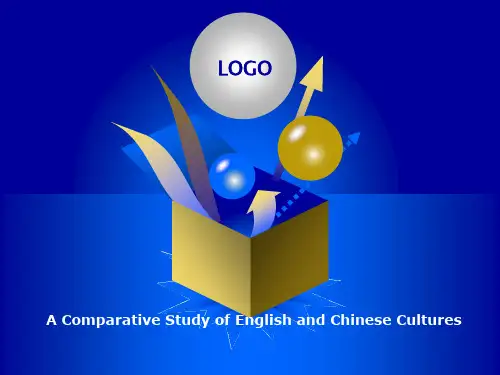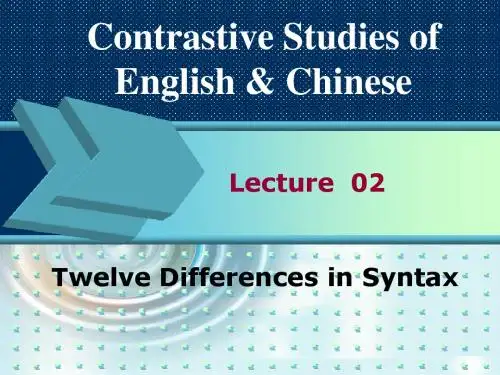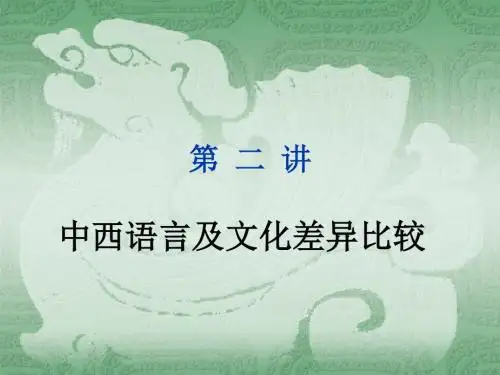汉英笔译 翻译第二章 汉英文化比较
- 格式:ppt
- 大小:2.51 MB
- 文档页数:44

中英文化对比及其翻译作文英文,Cultural differences between China and the West are significant, and it can be challenging to navigatethese differences when communicating or doing business with people from different cultures. One of the most significant differences is the emphasis on collectivism versus individualism. In China, family and community are highly valued, and decisions are often made with the group in mind. In contrast, Western cultures tend to place a higher emphasis on individualism, with personal achievement and success being highly valued.Another significant difference is the approach to time. In China, punctuality is not always a top priority, andthere is a more relaxed attitude towards timekeeping. In contrast, Western cultures place a high value on punctuality, and being late is often seen as disrespectful. This can cause misunderstandings and frustration when scheduling meetings or appointments.Language is also a significant cultural difference. In China, indirect communication is common, and people may avoid saying no directly to avoid causing offense. In contrast, Western cultures tend to place a higher value on direct communication and saying what you mean. This canlead to misunderstandings and confusion when communicating with people from different cultures.Finally, there are differences in social etiquette and customs. For example, in China, it is customary to offergifts as a sign of respect or gratitude, while in Western cultures, this can be seen as bribery. Understanding these differences can help avoid misunderstandings and build stronger relationships with people from different cultures.中文,中西方文化差异显著,与来自不同文化背景的人交流或做生意时,很难应对这些差异。
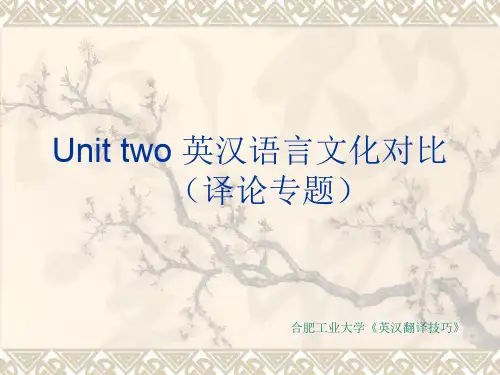

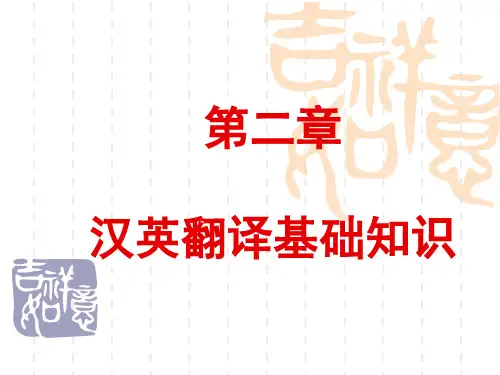
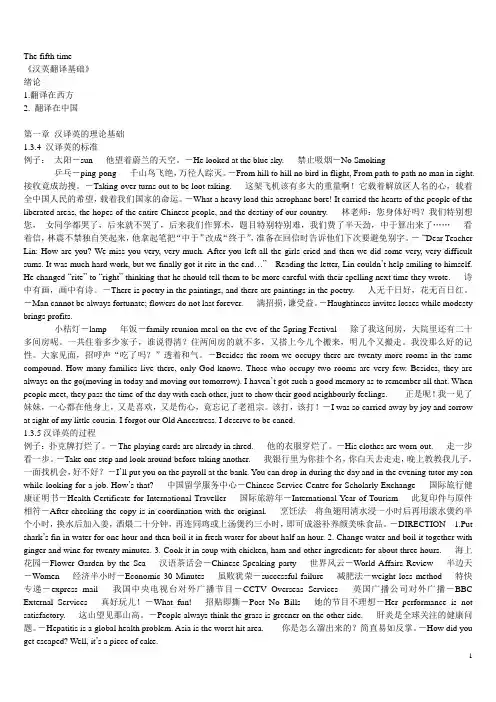
The fifth time《汉英翻译基础》绪论1.翻译在西方2. 翻译在中国第一章汉译英的理论基础1.3.4 汉译英的标准例子:太阳-sun 他望着蔚兰的天空。
-He looked at the blue sky. 禁止吸烟-No Smoking乒乓-ping-pong 千山鸟飞绝,万径人踪灭。
-From hill to hill no bird in flight, From path to path no man in sight. 接收竟成劫搜。
-Taking-over turns out to be loot-taking. 这架飞机该有多大的重量啊!它载着解放区人名的心,载着全中国人民的希望,载着我们国家的命运。
-What a heavy load this aerophane bore! It carried the hearts of the people of the liberated areas, the hopes of the entire Chinese people, and the destiny of our country. 林老师:您身体好吗?我们特别想您,女同学都哭了,后来就不哭了,后来我们作算术,题目特别特别难,我们费了半天劲,中于算出来了……看着信,林震不禁独自笑起来,他拿起笔把“中于”改成“终于”,准备在回信时告诉他们下次要避免别字。
-“Dear Teacher Lin: How are you? We miss you very, very much. After you left all the girls cried and then we did some very, very difficult sums. It was much hard work, but we finally got it rite in the end…”Reading the letter, Lin couldn’t help smiling to himself. He changed “rite” to “right” thinking that he should tell them to be more careful with their spelling next time they wrote. 诗中有画,画中有诗。
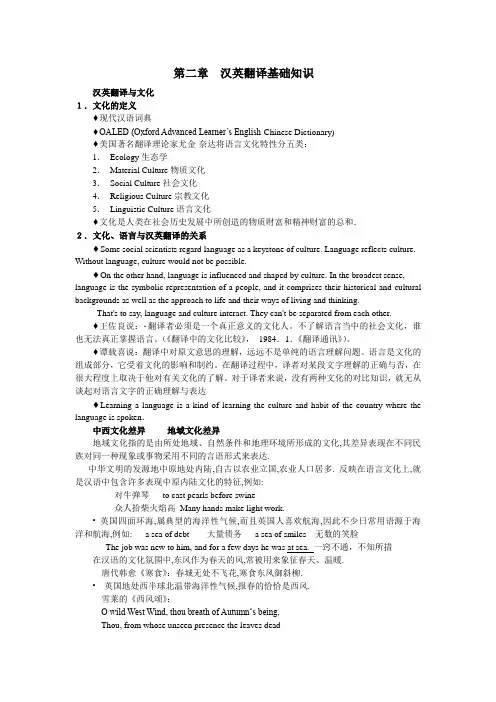
第二章汉英翻译基础知识汉英翻译与文化1.文化的定义♦现代汉语词典♦OALED (Oxford Advanced Learner‟s English-Chinese Dictionary)♦美国著名翻译理论家尤金·奈达将语言文化特性分五类:1.Ecology生态学2.Material Culture物质文化3.Social Culture社会文化4.Religious Culture宗教文化5.Linguistic Culture语言文化♦文化是人类在社会历史发展中所创造的物质财富和精神财富的总和.2.文化、语言与汉英翻译的关系♦Some social scientists regard language as a keystone of culture. Language reflects culture. Without language, culture would not be possible.♦On the other hand, language is influenced and shaped by culture. In the broadest sense, language is the symbolic representation of a people, and it comprises their historical and cultural backgrounds as well as the approach to life and their ways of living and thinking.That's to say, language and culture interact. They can't be separated from each other.♦王佐良说:翻译者必须是一个真正意义的文化人。
不了解语言当中的社会文化,谁也无法真正掌握语言。

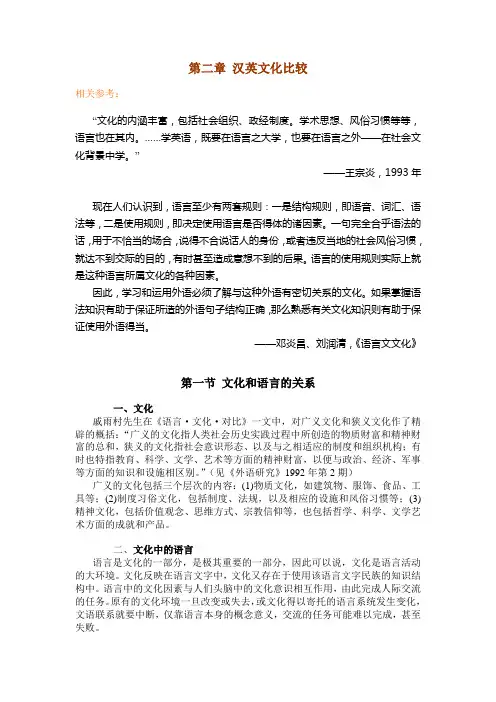
第二章汉英文化比较相关参考:“文化的内涵丰富,包括社会组织、政经制度。
学术思想、风俗习惯等等,语言也在其内。
……学英语,既要在语言之大学,也要在语言之外——在社会文化背景中学。
”——王宗炎,1993年现在人们认识到,语言至少有两套规则:一是结构规则,即语音、词汇、语法等,二是使用规则,即决定使用语言是否得体的诸因素。
一句完全合乎语法的话,用于不恰当的场合,说得不合说话人的身份,或者违反当地的社会风俗习惯,就达不到交际的目的,有时甚至造成意想不到的后果。
语言的使用规则实际上就是这种语言所属文化的各种因素。
因此,学习和运用外语必须了解与这种外语有密切关系的文化。
如果掌握语法知识有助于保证所造的外语句子结构正确,那么熟悉有关文化知识则有助于保证使用外语得当。
——邓炎昌、刘润清,《语言文文化》第一节文化和语言的关系一、文化戚雨村先生在《语言·文化·对比》一文中,对广义文化和狭义文化作了精辟的概括:“广义的文化指人类社会历史实践过程中所创造的物质财富和精神财富的总和,狭义的文化指社会意识形态、以及与之相适应的制度和组织机构;有时也特指教育、科学、文学、艺术等方面的精神财富,以便与政治、经济、军事等方面的知识和设施相区别。
”(见《外语研究》1992年第2期)广义的文化包括三个层次的内容:(1)物质文化,如建筑物、服饰、食品、工具等;(2)制度习俗文化,包括制度、法规,以及相应的设施和风俗习惯等;(3)精神文化,包括价值观念、思维方式、宗教信仰等,也包括哲学、科学、文学艺术方面的成就和产品。
二、文化中的语言语言是文化的一部分,是极其重要的一部分,因此可以说,文化是语言活动的大环境。
文化反映在语言文字中,文化又存在于使用该语言文字民族的知识结构中。
语言中的文化因素与人们头脑中的文化意识相互作用,由此完成人际交流的任务。
原有的文化环境一旦改变或失去,或文化得以寄托的语言系统发生变化,文语联系就要中断,仅靠语言本身的概念意义,交流的任务可能难以完成,甚至失败。
